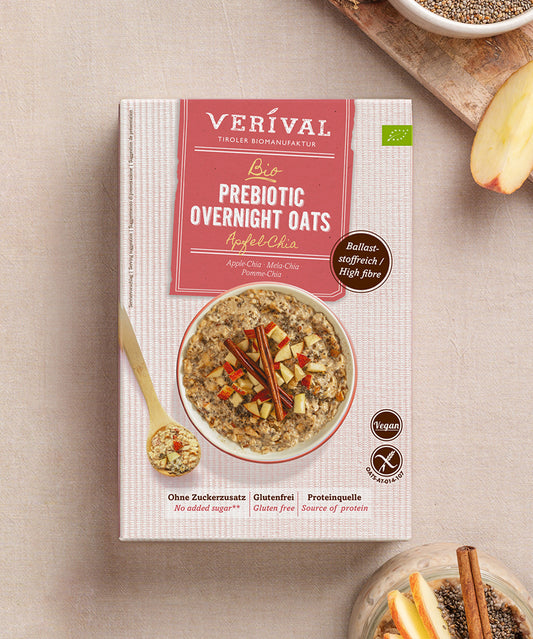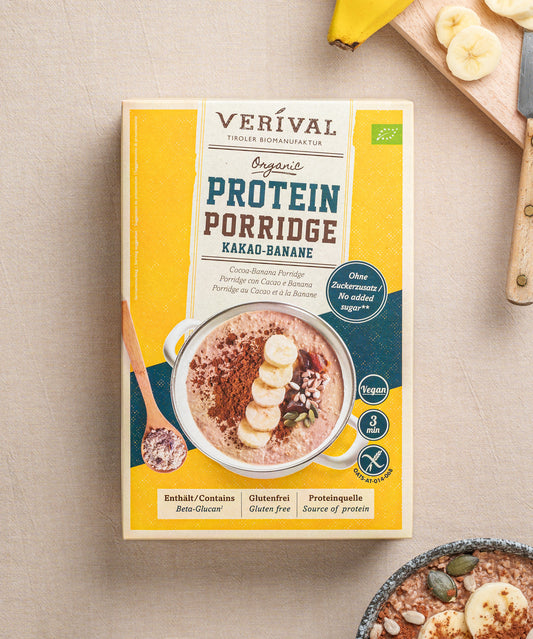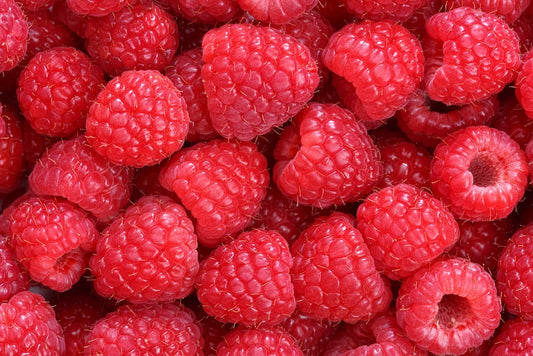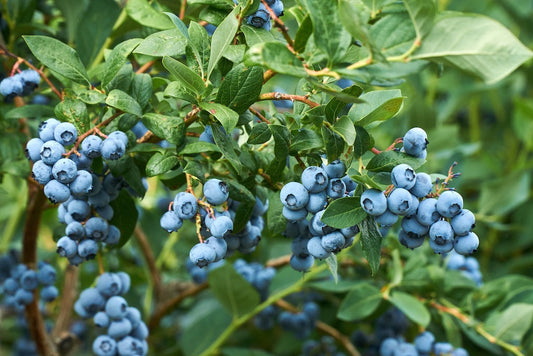Almonds are a member of the rose family and are thus direct relatives of the peach and the plum. The edible almond seed is surrounded by a hard shell that keeps the almond fresh. Most almonds are sold without the hard shell.
A distinction is made between the sweet almond (Krachmandel) and the bitter almond. The bitter almonds are not suitable for raw consumption. Liqueurs or bitter almond oil are often made from bitter almonds, which are mainly used to flavor baked goods.
Sweet almonds, whether brown, blanched, roasted, slivered, flaked or whole, are popular with many people for their sweet, mild flavor. Almonds are a particularly healthy snack due to their valuable nutrients.
But what makes almonds so versatile? How are they grown and where do they come from?
You can find the answers to these questions and much more useful information in this blog post.
We will also give you a few tips on how to incorporate almonds into your healthy diet and especially into your healthy breakfast.
How healthy are almonds really?
Almonds are so popular because they contain so many important nutrients. A handful of almonds contains 6 grams of protein, about 14 grams of fat and about 2 grams of carbohydrates.
Even though the fat content may seem very high at first glance, almonds mainly contain monounsaturated and polyunsaturated fatty acids, which, unlike saturated fatty acids, are particularly important and healthy for our body.
Nuts and almonds contain important antioxidants that help prevent cardiovascular diseases. The fiber and unsaturated fatty acids also have a positive effect on blood sugar levels.
What valuable nutrients do almonds contain?
As already mentioned, almonds are a wonderful source of high-quality unsaturated fatty acids. Almonds are also a good source of fiber, which aids digestion. The fiber is mainly found in the brown skin of the almonds.
The nuts also contain important vitamins and minerals such as vitamin E and B, calcium, potassium, magnesium, zinc and folic acid.
Almonds provide the following nutritional information per 100 grams:
Furthermore, the kernels lower cholesterol levels. However, you should still only eat about a handful of almonds a day, for example as a small snack between meals.
Here you will find a summary table with the most important macro- and micronutrients and the recommended reference values for adults according to the Austrian Society for Nutrition (ÖGE) and the German Society for Nutrition (DGE).
In comparison, you will find a daily dose of almonds, which corresponds to 30 grams and the corresponding proportion of macro- and micronutrients.
| Reference values for adults according to ÖGE/DGE | Almonds (30g) | |
| Potassium | 4000 mg | 250 mg |
| Calcium | 1000 mg | 76 mg |
| Vitamin E | 12-15 mg | 7.6 mg |
| Magnesium | 300-350 mg | 51 mg |
| Zinc | 7-16 mg | 0.7 mg |
| Fiber | 30 g | 4 g |
| Energy | individual | 175 kcal |
| Protein | individual | 5.6 g |
| Mono- and polyunsaturated fatty acids | individual | 3.9 g |
| Vitamin B2 | 1-1.4 mg | 0.3 mg |
| Folic acid | 300 µg | 13.5 µg |
How many almonds can I eat per day?
Even though almonds are generally a very healthy food, you should not eat more than 30 g per day. The official recommendation according to ÖGE for the maximum daily dose of sweet almonds is 30 grams of almonds, which is 1-2 tablespoons of nuts per day.
Even this small amount of almonds provides you with important nutrients. Nuts are also important for our brain and can even increase its performance. Therefore, a small portion of nuts should never be missing from your daily diet.
Do almonds make you fat?
Even though nuts are generally considered to be fattening, nuts do not necessarily make you fat despite their high calorie content. This is because almonds satiate you due to their high fiber and protein content.
However, due to their high calorie density, you should still make sure not to eat more than about 30 grams of almonds per day. If you incorporate nuts into your diet properly, nuts can even help you lose weight.
Tolerability of almonds
Since almonds have a very high content of healthy fats, they are therefore rather difficult to digest. Therefore, you should always make sure that you chew well when eating almonds. In general, however, fewer people have an allergic reaction to them than to hazelnuts, for example.
If you suffer from histamine intolerance, almonds are even better tolerated than peanuts or hazelnuts, for example. In addition, almonds are usually better tolerated when they are baked or in the form of nut oils.
Be careful with bitter almonds
In addition to the normal sweet almonds, there are also almonds that taste bitter. When eaten raw, bitter almonds are poisonous due to the prussic acid (amygdalin). However, as an adult, you would have to eat 50-60 of these almonds to suffer serious health problems.
For children, consuming just 5-10 bitter almonds can be dangerous. If the bitter almonds are processed, for example into almond flour and then baked, they are harmless to health.
However, the unpleasant bitter taste of these bitter almonds usually prevents the consumption of a dangerous dose.
How can you incorporate almonds into different meals?
It's not difficult to incorporate almonds into different meals. For example, you can easily add them to your cereal or porridge for breakfast.
Whether as a base for your porridge, chopped as a topping for your breakfast or simply as a snack, almonds are truly versatile.
Verival porridges with almonds – discover them here
Almonds can be used not only in sweet dishes, but also in savory dishes such as salads, pesto or in dressings.
In general, you should make sure to eat a handful of nuts every day as part of a healthy diet, as they have many positive effects on our body.
How to store almonds properly
Storing food correctly is generally very important as it has a positive effect on how long it stays fresh. Almonds of all kinds are best stored in a dark, cool and dry place.
This means that once you have opened the pack, it is best to store them in a well-sealable tin or glass jar. It is particularly important to keep them in a dry place, as mold can form if the almonds get damp.
Where do almonds come from and how are they processed?
The almond tree, also known as Prunus dulcis, is a member of the rose family and is best known for its delicate pink flowers. The almond blossom takes place annually between March and April.
The almond tree originally comes from Southwest Asia. The plant loves the Mediterranean climate and so today you can find these magnificent trees in the United States (mainly California), Australia, the Mediterranean region (mainly Spain), Iran, Pakistan and China. In botany, the almond is not considered a nut but a stone fruit.
From about 4-5 years of age, the almond trees bear the first almonds that can be harvested. The kernels require a dry and warm to hot climate in summer and mild winters.
They can only withstand very light and short frosts and do not tolerate waterlogging. The soil in which almond trees thrive must be humus-rich, permeable, loamy, sandy and slightly calcareous.
At the end of summer, the seeds of the almond tree develop from the blossom.
Ultimately, the almond kernel develops inside the blossom and is encased in a hard brown shell. Strictly speaking, the almond is not a nut, but a kernel.
As soon as the almond is ripe, the fruit casing bursts open and the harvest can begin. During the autumnal harvest of the almonds, the trees are shaken either by hand or by machine so that the fruit falls into nets.
They are then dried for one to two weeks and turned several times a day. During further processing, the shells of the almonds are broken open. They are then sorted using vibrating machines and checked for foreign bodies.
Almonds can be used and processed in many different ways. Products made from almonds include almond oil, almond butter, almond milk and marzipan. During the Christmas season, roasted almonds are particularly popular with young and old alike.
Where do the almonds in your Verival breakfast come from?
To guarantee the best possible quality, the almonds for the Verival mueslis and Verival porridges are carefully selected by our quality managers.
We source the almonds from a family business in Sicily that grows and processes them into a wide range of final products.
In July 2019, our quality managers also visited the farmers who grow the Verival almonds in person and were able to see for themselves the high quality.
Healthy porridge from Verival – find out more!
Use our BMI calculator now
With the Verival BMI calculator, you can quickly and easily calculate your BMI.
It doesn't matter whether you want to lose weight, just do something for your health or are in the middle of building muscle.
Body mass index is often the first measurement that shows you whether you have your body weight under control.
























